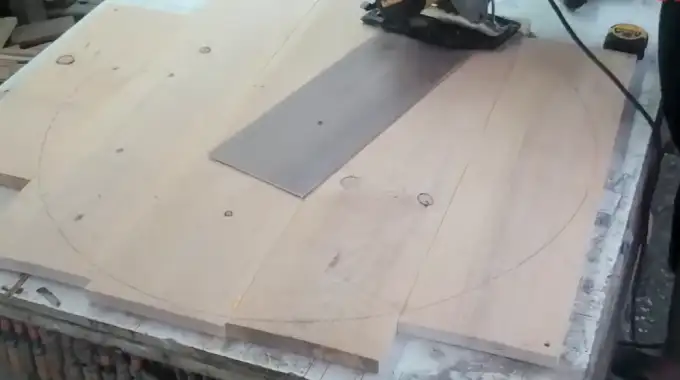How to Dry Wood Without Cracking? Expert Tips and Tricks
To dry wood without cracking, you need to control moisture loss slowly and evenly. Start by sealing the ends to slow drying and stack wood with stickers to promote airflow.
Monitor moisture regularly with a reliable meter, adjusting conditions to avoid too rapid drying. Use shade, elevated stacks, and controlled humidity where possible.
Chemical treatments like polyethylene glycol can also help stabilize wood cells. If you want to master these techniques and protect your wood from damage, keep exploring practical methods that suit your wood type and project.
Key Takeaways
- Dry wood slowly by stacking with stickers and ensuring even airflow to minimize internal stresses that cause cracking.
- Seal wood ends with wax or sealants to prevent rapid moisture loss and reduce checking during drying.
- Monitor moisture content regularly using moisture meters and adjust drying conditions to maintain steady, gradual drying.
- Use controlled environments like drying sheds or solar kilns with adjustable humidity and airflow to prevent uneven shrinkage.
- Apply chemical treatments like polyethylene glycol or surface sealants to stabilize wood cells and reduce drying stress.
Understanding the Causes of Wood Cracking
Although wood is a natural material, its tendency to crack during drying comes primarily from internal stresses caused by uneven shrinkage.
Wood cracks during drying mainly due to internal stresses from uneven shrinkage within its structure.
As you dry wood, you’ll notice radial shrinkage is about twice as much as tangential shrinkage. This pulls cells apart at different rates and leads to surface checks or deeper splits if not managed properly.
These internal stresses build as moisture leaves cells unevenly, especially when drying happens too fast or unevenly. Proper control of drying conditions, including managing temperature and humidity, is crucial to minimize these internal stresses.
Factors like grain orientation, density, and the presence of knots affect how these stresses develop.
Also, tension often starts with surface cracks that can worsen, so controlling drying conditions matters.
Monitoring and Managing Moisture Content
When you dry wood, consistently monitoring its moisture content is essential to prevent cracking and guarantee quality. Use moisture meters: pin-type for direct resistance and pinless for non-invasive checks. Apply species and temperature corrections for accuracy. Choosing the right tools for moisture measurement can significantly improve drying outcomes by providing precise moisture data.
Track moisture daily, especially above 30% MC, and compare readings against sample boards for reliability. The sample board method is the most effective way to monitor moisture content, involving weighing representative sections before and after oven drying at 215-218°F for about 24 hours. Adjust drying if cracks appear by slowing moisture loss. Employ sensors within kilns for real-time humidity and temperature data, aiding precise control.
| Method | Key Feature |
|---|---|
| Oven-drying | Most accurate, standard method |
| Pin-type meter | Direct, invasive resistance read |
| Pinless meter | Non-invasive, dielectric-based |
| Sample boards | Reliable moisture benchmarks |
| Digital sensors | Continuous real-time monitoring |
Techniques for Controlled and Slow Drying
To control the drying process effectively and minimize defects like cracking, you should use techniques that slow moisture loss and promote uniform evaporation.
Start by splitting logs into smaller pieces to reduce core moisture. Stack them with stickers, spacers that allow even airflow around each board, preventing uneven drying. It is also important to elevate the wood off the ground to prevent soil moisture absorption, which can interfere with the drying process.
Split logs into smaller pieces and stack with spacers to ensure even airflow and uniform drying.
Use drying sheds with adjustable walls and selective fans to manage humidity and airflow without adding heat. This ensures slow, uniform drying.
Solar kilns offer accelerated but controlled drying by capturing solar heat and maintaining temperatures around 150°F. However, they require careful monitoring to avoid surface checking.
Mechanical airflow control with intermittent fans and dehumidifiers helps maintain steady humidity and temperature, preventing rapid moisture loss.
Chemical Treatments to Prevent Shrinkage and Cracks
Because drying wood inevitably causes moisture loss that leads to shrinkage and cracks, you can apply chemical treatments to stabilize the wood’s dimensions and reduce internal stress.
Polyethylene glycol (PEG) penetrates wood cells, replacing water and minimizing drying stress. Aim for 25-30% uptake at 70-140°F, though treatment can take weeks depending on thickness. To further protect the wood surface, applying a sealant or stabilizer after treatment can block outside air contact and slow moisture evaporation. Incorporating a dust collection system during woodworking can also help maintain wood quality by reducing airborne moisture fluctuations.
Oil-based sealants like tung or Danish oil form moisture barriers, slowing evaporation and reducing surface checking. Note outdoor wood needs reapplication every two years.
Polymer impregnation uses vacuum-pressure to fill cells with rigid plastics, physically stabilizing wood internally. This method is ideal for valuable large pieces but costly.
Salt pastes, such as sodium silicate, slow surface moisture loss, preventing rapid shrinkage but work best on thin pieces.
Best Practices for Drying Different Wood Forms
Applying chemical treatments can markedly reduce shrinkage and cracking, but controlling the drying process itself plays a major role in preserving wood quality.
For lumber, stack it promptly with kiln-dried stickers spaced evenly and oriented perpendicular to prevailing winds. Cover tops to shield from rain while ensuring airflow. This traditional air drying method is cost-effective and environmentally friendly, making it suitable for large quantities of timber.
Kiln drying demands careful control of temperature, humidity, and air velocity. Start with moderate heat to avoid surface checks and equalize moisture within boards.
When drying large logs, seal ends immediately, store off the ground, cover tops, rotate periodically, and allow air circulation around each log.
For wood turnings, slow drying in controlled environments with end sealants is crucial, avoiding direct heat. Problematic species require slower schedules, end coatings, and monitoring for internal stresses to prevent defects.
Frequently Asked Questions
Can Dried Wood Regain Moisture Without Cracking?
Yes, dried wood can regain moisture without cracking if you manage the process carefully.
You’ll want to guarantee the moisture reabsorption happens gradually by controlling humidity and temperature.
Avoid rapid environmental changes, store wood properly with good air circulation, and consider using end coatings to slow moisture movement.
Using a moisture meter helps you monitor progress.
Allowing the wood to acclimate before working with it reduces the risk of cracks or other defects.
How Does Wood Species Affect Drying Time?
Wood species directly impact drying time because of differences in density and moisture retention.
Hardwoods like oak take longer, up to 12 months per inch, while softwoods like pine dry much faster, around 2 to 4 months.
You’ll notice that denser woods hold moisture internally, requiring slower drying to avoid defects.
What Tools Measure Wood Moisture Accurately?
Imagine holding a piece of wood, its surface cool and slightly damp under your fingers.
To measure moisture accurately, you’ll want a high-quality wood moisture meter.
Pin-based meters give core readings but leave tiny holes.
Pinless meters scan up to ¾ inch deep without damage.
For precision, choose meters like the Bessemeter D300 or mini-Ligno DX/C.
These offer species correction and tight accuracy within 0.1%.
These tools help you monitor moisture confidently.
Is Kiln Drying Suitable for All Wood Types?
Kiln drying is suitable for most wood types, including hardwoods like cherry and softwoods like pine.
However, you’ll need to adjust drying schedules carefully. Dense woods like white oak require slower drying to prevent cracking.
Also, mixing species can risk uneven drying. When drying thick lumber or chemically treated wood, expect longer, customized cycles.
How Long Should Wood Cure After Drying?
You should let wood cure about one year per inch of thickness if it’s air-dried hardwood.
For softwoods, allow 6 to 12 months per inch.
Kiln-dried wood cures much faster, usually within days to weeks, and only needs a short acclimation period.
Always check that moisture content reaches 6–8% for indoor use before considering curing complete.
Master Moisture Control to Prevent Wood Cracks
To dry wood without cracking, picture a gentle sunrise slowly warming a misty forest. Patience and control are your best tools.
You’ll carefully monitor moisture, letting the wood release water at its own pace. Avoid sudden changes that cause stress.
Use chemical treatments wisely to keep fibers supple. Adapt methods for each wood form. By mastering these steps, you’ll preserve the wood’s strength and beauty, preventing those frustrating, costly cracks.







